Jack, H., Hawks, V., “Trends in Manufacturing Education: An Educators View”, ASEE Annual Meeting, Louisville, KY, June 2010.
Trends in Manufacturing Education: An Educators View
Dr. Hugh Jack P. Eng (Grand Valley State University) and Dr. Val Hawks (Brigham Young University)
Abstract
Recently there has been a renewed appreciation of the important role of the manufacturing sector in creating jobs to revitalize the economy and maintain national economic strength. Rapidly changing technologies and increased complexity of the whole production supply chain have resulted in many changes in the standard manufacturing body of knowledge and, as a result, changes in manufacturing education. Manufacturing professionals and educators alike welcome this focus on manufacturing and are responding. Groups such as the American Society for Engineering Education (ASEE) Manufacturing Division and the Society of Manufacturing Engineers (SME) have always been active in describing the discipline of manufacturing and are continuing to take action. Recent major planning efforts include The Four Pillars of Manufacturing Engineering1 and the development of Curricula 20152.
While individual manufacturing educators and manufacturing-focused groups are aware of the changes in the discipline and practice, there is currently no comprehensive historical analysis of trends in manufacturing education. One method of analyzing these trends is to examine publications and presentations over a number of years to estimate what and when topics are emerging, maturing, or waning.
This paper analyzes the topical distribution of past papers and presentations in ASEE annual conference proceedings. The topic frequency is presented by year, providing a context to understand the historical path to the current manufacturing education efforts. The approach is three fold; 1) Gather a database of papers, presentations and related works that address manufacturing education over the past two decades; 2) Conduct a comprehensive assessment of the collected material in order to identify the major themes in manufacturing curriculum and methods in manufacturing education; and 3) Determine what lessons are evident in the development of manufacturing education and how such lessons can inform current practices and help identify and define future opportunities.
1. Introduction
Manufacturing industries and education are now emerging from a decade long slump in social and political support. The most notable example of renewed support is the Advanced Manufacturing Initiative supported by the political leaders of the US3. The appreciation of the importance of manufacturing is not new to those who have been intimately involved in manufacturing and manufacturing education4. Education is crucial to providing a capable workforce to fill the needs of manufacturing companies as well as to advance the knowledge and methods of manufacturing.
For several decades the American Society of Engineering Education (ASEE) has held annual conferences to provide a venue for discussions of engineering education. It can be helpful to step back and take a look at the things presented in such conferences to better understand how a discipline is emerging and changing. It can also be helpful to simply look at a couple of decades of topics as simply a point of interest or a point of departure for further inquiry and discussion. It is these points that provide the motivations for this paper.
Here in we will show data that reveals evolving interests in topics related to manufacturing education, as presented in the annual ASEE conference since 1981. The charts illustrate what topics have been presented at the ASEE Annual Conference by year, thus illustrating the variations in scholarly activity.
2. Method
The source for the study is the proceedings for the past 30 years of the ASEE annual conference. Papers were reviewed to identify the main topic of the paper. In some cases it was apparent that there were two main topics for the paper and in those cases both topics were used. To avoid imposing personal biases the topic categories were defined by reading the papers to identify the main topic (or in a few cases two main topics) that emerge from the papers. The result of this approach was a set of 21 high frequency topics, and another 43 less common.
A spreadsheet was used to track the topic frequency and then the results were manipulated to obtain; 1) the total top occurrences, 2) top occurrences for each year, and 3) a time series of each of the total top occurrence topics. Charts were generated for each topic by year and overall. Yearly distribution charts for the 21 high frequency topics are presented in the Appendix, or in the body as appropriate.
This paper does not try to determine anything more than numbers of topics. For example, the paper does not consider qualitative versus quantitative analysis. Moreover the topics are somewhat broad and do not describe more subtle changes over time.
3. Results
As a distinct discipline manufacturing is still relatively new, with the ASEE Manufacturing Division only being formed in 19855. However, the overall presence of manufacturing specific papers has normally been above 2% of the entire conference, see Figure 1. These numbers do not include papers that had another emphasis but still addressed various aspect of manufacturing. The peaks in 1987, 1993, 1998, and 2001 suggest that it is possible for the number of manufacturing papers to increase to 10% of the conference total.

Figure 1 - Percentage of Manufacturing Papers at the ASEE Annual Conferences
Figure 2 shows the overall top occurrences in the last two decades for topics that had appeared 10 times. This does not include the 43 topics had an occurrence total of less than 10 and were categorized under the label of Other which shows up as second highest topic in figure 1. For the information of the reader, a list of these Other topics is included in Appendix A as Table 1. The relative size of the Other topics to the overall distribution indicates that a cutoff of 10 publications is reasonable. Disregarding the Other topic categories, the two highest occurrences are papers on Curriculum and Lab Based Learning. That these two topics are so common is not very surprising, after all this is in an engineering education venue.

Figure 2 - Top Paper Keyword Distribution Over All Years
The Laboratory Learning papers, Figure 3, have grown to a high of 16 in 2009. The steady increase in the number of papers validates the importance of, and interest in, labs and laboratory work to manufacturing education. The data suggests that the number of lab papers will continue to grow. The trend for curriculum papers, Figure 4, is quite steady and suggests a range of 2-3 per year is reasonable.
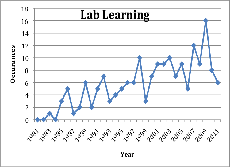
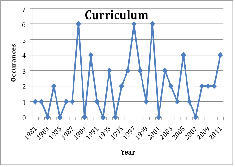 Figure 3 Laboratory Learning Papers by Year Figure 4 - Curriculum Papers by Year
Figure 3 Laboratory Learning Papers by Year Figure 4 - Curriculum Papers by Year
There are some interesting things going on with respect to specific manufacturing topics. Not necessarily surprising, but still, the data illustrates that some topics have come and gone, some have stayed and others emerged. For example, prior to 2002 there were a total of 5 papers (between 1992 and 1996) on Lean and Six Sigma shown in Figure 6. Since 2003 this topic has averaged 4.3 papers per year with a low of 3 in 2011. Simulation, Figure 5, has been around for sometime and the interest in it has as well with papers about it averaging 2.4 papers per year over the last decade and a half.
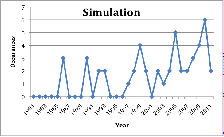
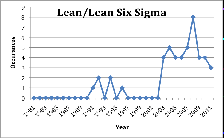
Figure 5 - Simulation Papers by Year Figure 6 - Lean Manufacturing Papers by Year
Awareness of manufacturing, Figure 8, has to do with the image of manufacturing as a professional discipline and an attractive option for students to pursue as a career. Thus papers in this realm address what are normally called pipeline issues (getting students in to the majors) as well as why they should consider manufacturing as a career. This has always been a point of interest and concern but the data show much more attention was paid to it in the last decade as opposed to the previous decade. The need of manufacturing students to be competent in communication, inter-personal skills, teamwork, etc. is often referred to as soft skills. This topic has also had some consistent attention but as shown in Figure 7, there has been a slight increase over the last decade.

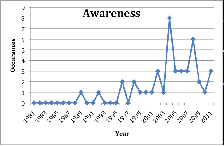
Figure 7 - Soft Skills Papers by Year Figure 8 - Awareness of Manufacturing Papers by Year
New and emerging topics are shown to be coming on-line in the ASEE venue. As can be seen in Figures 9-12 topics Green Manufactuirng, Nanomanufacturing and Additive Manufacturing (a bit more established we know) have seen a significant increase in the last decade and will likely continue. Other topics such as micro-manufactuirng (7), biomanufacturing (5) and mechatronics (1) are noted here,but each has a totoal of less than 10 thus though they didn’t make the “top” list but are indicitive of the increase of papers in the emerging technologies area.
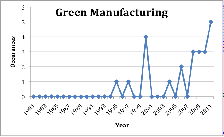
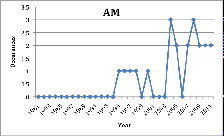
Figure 9 - Green Manufact. Papers by Year Figure 10 - Additive Manufact. Papers by Year
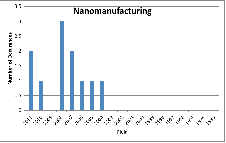
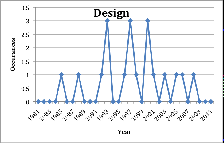
Figure 11 - Nanomanufact. Papers by Year Figure 12 - Design Papers by Year
It is interesting to note that although design is crucial in manufacturing and other engineering disciplines, the topic itself has decreased in occurrences and over the last 5 year there have been one or less per year, Figure 12. It may be that this topic has taken on an interdisciplinary approach or is nested with Computer-aided design or in some way changes in description. Still a deeper look at the topic of design, how it relates to manufacturing and papers in that area might be of interest.
Likewise interesting is the cessation of papers on the topics of Interdisciplinary manufacturing, Figure 14, and Computer Integrated Manufacturing, Figure 13. Though again the totals for these topics are not high, coming in at 14 and 13 respectively, it is curious that there are no papers on these topics in the last few years. It would be interesting to ask why this is the case, for though CIM may be seen as an outdated concept and interdisciplinary a faddish idea, both of these topics are still very much a part of the global, system oriented manufacturing arena of today. However, it may also be an issue of selection by reviewers or even authors themselves. With the reduction in these papers, we see an increase, as noted earlier, of papers on emerging topics, curriculum, pipeline, etc.. Thus, it may simply be a matter of choice rather than a comment on importance.
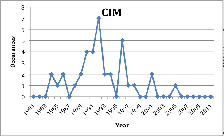
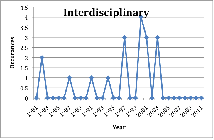
Figure 13 - CIM Papers by Year Figure 14 - Interdisciplinary Papers by Year
4. Conclusions
The clear focus on Laboratories for applied learning and a high level of interest in curriculum suggests the C2015 and Four Pillars of Manufacturing Engineering are well timed to help standardize the manufacturing curriculum and provide a base for program changes and new program design.
It would be of interest to do further study and analysis on some questions that arise from this analysis. For example:
Why are there so few papers on design in manufacturing?
What has happened to the interest in CIM, Interdisciplinary, Local Industry, and Quality?
Can we do more to encourage publishing growth in the newer interest areas like Green Manufacturing, Nanotechnology, Additive Manufacturing, Lean/Six Sigma, and Advanced Manufacturing Technologies?
Are there topics rarely seen that should be promoted by a call for papers?
Should one or more special sessions be offered for more popular topics.
The graphs show a number of trends that will inform future authors and reviewers such as we can expect more papers on topics including simulation, soft skills, systems, and business aspects of global manufacturing. Also it would seem we should expect to see more papers on manufacturing awareness/pipeline as results from the focus on manufacturing as a national priority increase. It will be important that the pipeline be filled with prepared and capable students.
Acknowledgments
The authors would like to thank Tyler Sharp, an undergraduate student in Manufacturing Engineering Technology at BYU, his help has been invaluable in the effort of collecting and analyzing the data.
References
1. Robert Mott, Hugh Jack, Venkitaswamy Raju, Mark Stratton, "The Four Pillars of Manufacturing Engineering“, SME Annual Meeting, Bellevue, WA, June 2011.
2. Hugh Jack, Robert Mott, Venkitaswamy Raju, Gary Conkol, Mark Stratton, Phil Waldrop, Karen Wosczyna-Birch, & Seth Bates, “Curricula 2015; A Four Year Strategic Plan for Manufacturing Education”, SME, 2011, retrieved from
http://www.C2015.com
.
3. National Science and Technology Council, A National Strategic Plan for Advanced Manufacturing, Office of the President, Washington, D.C., February 2012. Retrieved March 5, 2012 from http://www.whitehouse.gov/sites/default/files/microsites/ostp/iam_advancedmanufacturing_strategicplan_2012.pdf .
4. Hugh Jack, “The 2012 State of Manufacturing Education”, ASEE Annual Meeting, San Antonio, TX, June 2012.
5. David Wells, “Challenges And Responses Over A Quarter Century Of Manufacturing Education”, ASEE Annual Meeting, Louisville, KY, June 2010.
Appendix A - Topics with Fewer than 10 Occurrences
Table 1 - Paper Keywords Cited Less Often